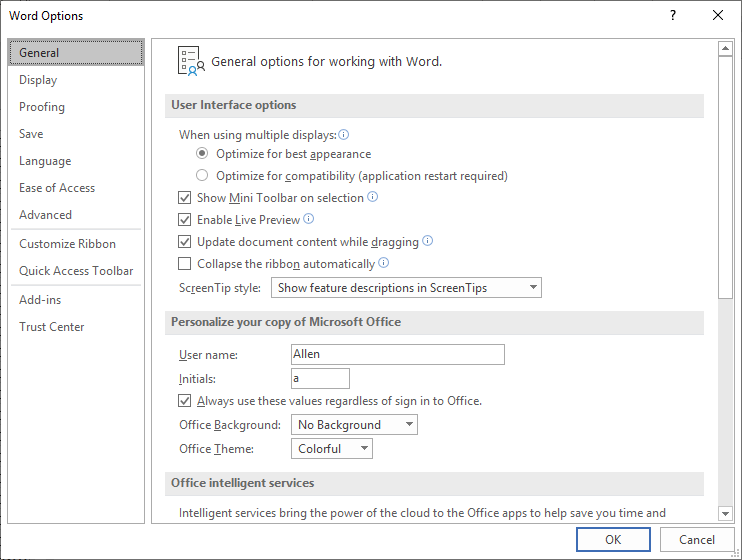Please Note: This article is written for users of the following Microsoft Word versions: 2007, 2010, 2013, 2016, 2019, and 2021. If you are using an earlier version (Word 2003 or earlier), this tip may not work for you. For a version of this tip written specifically for earlier versions of Word, click here: Setting User Information.
Written by Allen Wyatt (last updated March 20, 2021)
This tip applies to Word 2007, 2010, 2013, 2016, 2019, and 2021
When you first install Word, it asks you for your name so it can personalize the registration for your program. It also writes your name into the user area. This area includes your name and initials and can include your address. This information is used by various Word fields, in the document summary information, in annotations, and in the Envelopes and Labels feature.
If you need to change the user information (for instance, if your name or address changes), follow these steps:

Figure 1. The General options of the Word Options dialog box.

Figure 2. The Advanced options of the Word Options dialog box.
WordTips is your source for cost-effective Microsoft Word training. (Microsoft Word is the most popular word processing software in the world.) This tip (9539) applies to Microsoft Word 2007, 2010, 2013, 2016, 2019, and 2021. You can find a version of this tip for the older menu interface of Word here: Setting User Information.

Do More in Less Time! An easy-to-understand guide to the more advanced features available in the Microsoft 365 version of Word. Enhance the quality of your documents and boost productivity in any field with this in-depth resource. Complete your Word-related tasks more efficiently as you unlock lesser-known tools and learn to quickly access the features you need. Check out Microsoft 365 Word For Professionals For Dummies today!
Word normally uses Print Layout view to display your documents. You may want, instead, to always use Draft view. Here's ...
Discover MoreDo Word's attempts to be helpful drive you nuts? Here's a way that you can turn off at least some of the helpfulness.
Discover MoreWhen you use Word, it normally performs several tasks in the background while you are typing. One of those tasks is to ...
Discover MoreFREE SERVICE: Get tips like this every week in WordTips, a free productivity newsletter. Enter your address and click "Subscribe."
There are currently no comments for this tip. (Be the first to leave your comment—just use the simple form above!)
Got a version of Word that uses the ribbon interface (Word 2007 or later)? This site is for you! If you use an earlier version of Word, visit our WordTips site focusing on the menu interface.
Visit the WordTips channel on YouTube
FREE SERVICE: Get tips like this every week in WordTips, a free productivity newsletter. Enter your address and click "Subscribe."
Copyright © 2025 Sharon Parq Associates, Inc.
Comments